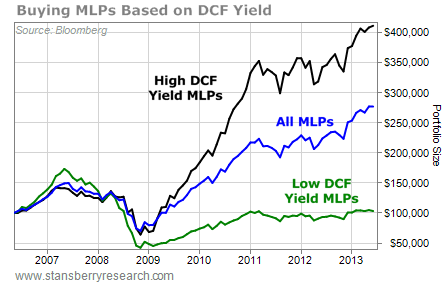 I have another simple “trading for income” strategy to show you today…
I have another simple “trading for income” strategy to show you today…
Yesterday, I walked you through how to time your purchase of dividend-paying stocks.
Today, I’ll show you something similar… using one of the market’s most popular income investments…
Master limited partnerships (MLPs) collect simple income-producing energy assets – like pipelines and natural gas storage tanks – and package them into an investment you can buy, just like a stock.
[ad#Google Adsense 336×280-IA]MLPs don’t have to pay corporate taxes on their income…
In exchange, they must pay 90% of their income to shareholders.
That makes them popular income investments.
But like any investment, you’ll do better if you buy the right MLPs at the right time…
The first “test” I use for MLPs is to look at the “distributable cash flow yield.”
It’s simpler than it sounds…
Distributable cash flow (DCF) is the money available to give to shareholders. And when I’m thinking about buying an MLP, I want to know if I can get that stream of cash for a good price.
For example… take an MLP priced at $10 that generates $1 in distributable cash flow per year. Its DCF yield is 10% ($1 divided by $10).
All things being equal, you’d want a higher DCF yield. You’d be collecting more cash for your investment dollar. And my research proves it out…
Going back to mid-2006 (seven years), I looked at your returns if you bought the top 20% of higher-yielding MLPs. And I compared them to your returns if you bought the bottom 20% of lower-yielding MLPs, rebalancing each month.
Take a look at the results… You can see the MLPs with high DCF yields had significantly higher capital gains. (And they fell less in the 2007-2008 downturn.)
 The second “test” I use for MLPs is to look at whether the overall sector is a good buy…
The second “test” I use for MLPs is to look at whether the overall sector is a good buy…
I start by comparing the DCF yield on MLPs as a whole to the yield on 10-year corporate bonds. The more MLPs pay compared to corporate bonds – the bigger the “spread” – the better. It means MLPs offer a better relative value.
Next, I take that spread and compare it to the average spread over the last year. That lets me pinpoint short-term selloffs, which can be great times to buy.
When the indicator is below -0.5, it’s time to buy MLPs. And when it’s above 0.5, it’s time to sell. You can see the spread indicator captured the bull market from 2009 to 2011 and got out before things got volatile in 2012.
 When you combine these two signals – high DCF yield and low score on the spread indicator – you can see tremendous profits.
When you combine these two signals – high DCF yield and low score on the spread indicator – you can see tremendous profits.
From September 2009 to August 2011, the spread indicator showed that MLPs were a buy. Had you bought the MLPs with the highest DCF yield at the time, you would have ended up with the following returns…
 That’s an average 88% return (not including dividends). Compare that to the average two-year return of the MLP index… It’s just 22%.
That’s an average 88% return (not including dividends). Compare that to the average two-year return of the MLP index… It’s just 22%.
On a $100,000 MLP portfolio, that’s a $66,000 difference.
Right now, the spread indicator says MLPs are a buy… And the MLPs with the highest DCF yield are Alliance Resource Partners (ARLP), Navios Maritime Partners (NMM), Teekay Offshore Partners (TOO), and Martin Midstream Partners (MMLP).
These are not official recommendations. But if you’re looking to buy MLPs, it’s a place to start your research.
Here’s to our health, wealth, and a great retirement,
Dr. David Eifrig
[ad#stansberry-ps]
Source: The Growth Stock Wire
